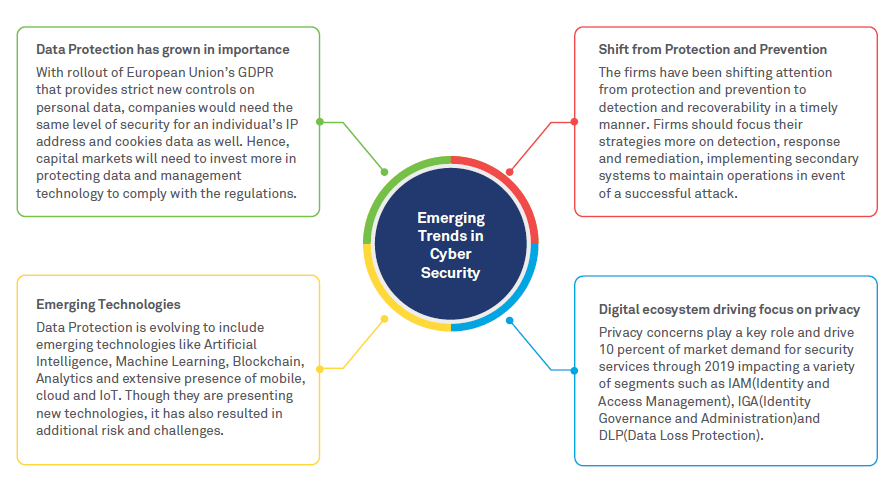The cybersecurity landscape is evolving.
Thanks to new advances in technology, the future is looking bright for the industry. Artificial intelligence, machine learning, IoT, blockchain, 5G - these advancements will be part of what lies ahead. However, all this sophisticated new tech has a dark side: both sides can use it. Now, the struggle between cybersecurity and cybercrime has become even more complicated.
A new breach or zero-day attack targeting brands and government agencies seem to be happening each month. There have been several high-profile attacks this year alone. WhatsApp, NordVPN, the U.S. Customs, and Border Protection, and a slew of others have suffered breaches.

Here are seven emerging technologies that would make these attacks look elementary.
Compromised Artificial Intelligence
The applications for AI in government, business, and healthcare are limitless. For instance, AI can use crime statistics and criminal records data to create more accurate prediction tools that may decrease crime. Artificial intelligence can also help speed up the research and development of new, life-saving drugs.
In the wrong hands, however, AI can become a severe threat. Hackers are already using the technology to circumvent and outsmart cybersecurity defenses. Cybercriminals can use AI-powered programs to scan networks and reveal their vulnerabilities. AI-predictive text can impersonate high-value individuals and dupe targets into divulging private information.
Attackers Abuse the Cloud and Exploit Encryption
Hackers are already using encryption and sandboxing to hide in plain sight, and they're getting better at it. Encryption is a great tool to protect regular traffic, but it can also inadvertently conceal bad traffic from detection. Cybercriminals use popular cloud services to hide, control, and distribute malware. This technique is challenging to catch using traditional security tools because it looks like regular traffic.
Self-propagating Malware
In the old days, it took two to do the malware tango. The first dancer was the corrupted link, file, or program, while the other was the user. The user had to open an attachment, download a file, or do some other action before the malware could spread. Today, there are newer forms of hybrid malware, and all are scary.
Take ransomware crypto worms, for instance. These buggers are network-based and don't need human intervention to spread. Malware that self-propagates is tougher to catch and can spread at the speed of the network they're in. Security experts agree that self-propagating malware can potentially take down the internet.
Exploiting Vulnerabilities in 5G
As carriers start pushing 5G as the faster, next-gen wireless network with more bandwidth, hackers can use the transition to attack. The targets would be 5G devices and systems using the web, and the most likely method would be a DDoS attack. The increased speed and bandwidth means more data can flood the servers with traffic, shutting them down.
Financial and Security Scams Using Deepfake Technology
You've probably seen "deep fakes" of Tom Cruise and Donald Trump in action on YouTube. Deepfake technology lets people manipulate audio and video in a very realistic way. Face-swapping filters on Snapchat and Instagram are basic versions of this technology. Sophisticated and well-made deep fakes are tough to spot, you'll have a hard time distinguishing it from the real thing.
It's this level of sophistication that is worrisome. Sure, the creators of celebrity deepfakes do it for kicks and to show off the capabilities of the tech. However, many cybersecurity experts warn that hackers could use the technology for fraud and phishing scams. Cybercriminals can pose as someone else to trick people into handing over money or sensitive information.
The only course of action is to fight fire with fire or AI with AI. Several companies are developing AI-powered software that can detect deep fakes, but the process will take a while.
Cybercriminals use the "Internet of Things" as a New Attack Vector
The Internet of Things (IoT) has become part of the lives of countless people over the years. The best example of the technology in use is a smart home network. Home devices and appliances can communicate with each other via the internet. Homeowners can also control devices remotely, such as turning a light on and off or viewing an IP camera. IoT technology is also used in all types of businesses.
As useful as IoT has been, the technology carries with it several security flaws:
- Individuals or teams that deploy IoT devices leave them unmonitored.
- Many IoT devices create "back doors" into other systems, leaving them vulnerable to attack.
- IoT vendors have historically done a poor job of patching their devices to address known security issues.
- Most IoT endpoints have no security capabilities.
Hackers are getting better and evolving at a faster rate because they have more tools at their disposal.
Quantum Computers Capable of Cracking Encrypted Data
Quantum computing has always been theoretical, but Google had other plans. The search giant announced in September that they built a functioning quantum computer. Even if the technology has no practical applications yet, everyone must take precautions from here on out.
The development of a working quantum computer is a wonderful computer engineering achievement. However, it can spell the apocalypse for the encryption world. Anybody who can get his or her hands on one can hack into practically anything using the power of quantum physics. All this computing power can break the encryption protocols used in passwords, credit card transactions, and even blockchain.

Conclusion
It has always been a high-stakes chess match between security experts and cybercriminals. Although the emergence of new technologies is great for the industry as a whole, it also poses a threat to everyone. AI-assisted hackers can break into criminal records databases to extort people with prior records to pay a ransom. Quantum computers in the wrong hands can easily break encrypted transactions. Network-based malware can shut down the entire internet.

